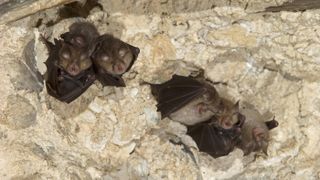
Researchers have discovered coronaviruses lurking in Laotian bats that appear to be the closest known relatives to SARS-CoV-2, the virus that causes COVID-19, found to date, according to news reports.
In a new study, researchers from the Pasteur Institute in France and the University of Laos captured 645 bats from limestone caves in northern Laos and screened them for viruses related to SARS-CoV-2. They found three viruses — which they dubbed BANAL-52, BANAL-103 and BANAL-236 — that infected horseshoe bats and shared more than 95% of their overall genome with SARS-CoV-2.
One of the viruses, BANAL-52, was 96.8% identical to SARS-CoV-2, according to Nature News. That makes BANAL-52 more genetically similar to SARS-CoV-2 than any other known virus. Previously, the closest known relative to SARS-CoV-2 was RaTG13, which was found in horseshoe bats in 2013 and shares 96.1% of its genome with SARS-CoV-2, Nature News reported.
Related: 7 facts about the origin of the novel coronavirus
What’s more, all three of the newly discovered viruses are more similar to SARS-CoV-2 in a key part of their genome — called the receptor binding domain (RBD) — than other known viruses. The RBD is the part of the virus that allows it to bind to host cells. With SARS-CoV-2, the RBD binds to a receptor known as ACE2 on human cells, and the virus uses this receptor as a gateway into cells.
Critically, the new study found that BANAL-52, BANAL-103 and BANAL-236 can bind to ACE2 and use it to enter human cells. So far, other candidates proposed as ancestors of SARS-CoV-2 found in bats, including RaTG13, haven’t been able to do this, the researchers said. The three viruses could bind to ACE2 about as well as early strains of SARS-CoV-2 found in Wuhan, they said.
The findings, which were posted to the preprint server Research Square on Sept. 17, add to the evidence that SARS-CoV-2 had a natural origin, rather than escaping from a lab.
The results show “that sequences very close to those of the early strains of SARS-CoV-2 … exist in nature,” the researchers wrote in their paper, which has yet to be peer-reviewed.
“The receptor binding domain of SARS-CoV-2 looked unusual when it was first discovered because there were so few viruses to compare it to,” Edward Holmes, an evolutionary biologist at the University of Sydney, who wasn’t involved in the research, told Bloomberg. “Now that we are sampling more from nature, we are starting to find these closely related bits of gene sequence,” Holmes said.
The authors say their findings support the hypothesis that SARS-CoV-2 resulted from a recombination of viral sequences existing in horseshoe bats.
Still, even though the newly discovered viruses are closely related to SARS-CoV-2, all three viruses lack a sequence for what is known as the “furin cleavage site,” which is seen in SARS-CoV-2 and aids the virus’s entry into cells, according to Nature News. This means that in order to better understand the origins of SARS-CoV-2 further research is needed to show how and when the furin site was introduced.
The findings are currently being considered for publication in a Nature journal, Bloomberg reported.
Originally published on Live Science.

Rachael has been with Live Science since 2010. She has a master’s degree in journalism from New York University’s Science, Health and Environmental Reporting Program. She also holds a B.S. in molecular biology and an M.S. in biology from the University of California, San Diego. Her work has appeared in Scienceline, The Washington Post and Scientific American.
Note: This article have been indexed to our site. We do not claim legitimacy, ownership or copyright of any of the content above. To see the article at original source Click Here












